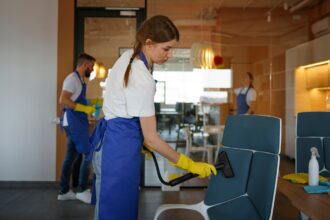The Science Behind Effective Commercial Cleaning Techniques
As businesses strive to create a positive impression, effective commercial cleaning techniques play a crucial role.
Understanding the Importance of Cleanliness
A clean workspace boosts employee morale, enhances productivity, and ensures customer satisfaction. Conversely, neglecting cleanliness can lead to health hazards, reputational damage, and financial losses.
The Science of Cleaning: Breaking Down the Basics
Cleaning involves the removal of dirt, dust, and other unwanted substances from surfaces. This process requires an understanding of surface chemistry, microbiology, and the principles of cleaning agents.
Surface Chemistry: The Key to Effective Cleaning
Surface chemistry explains how cleaning agents interact with dirt and surfaces. Understanding the pH levels, ionic charges, and solubility properties of cleaning agents ensures effective dirt removal.
Microbiology: The Unseen Enemy
Microorganisms thrive on dirty surfaces, posing health risks to occupants. Effective cleaning techniques must eliminate these microorganisms to prevent illnesses and maintain a healthy environment.
Cleaning Agents: The Right Tool for the Job
Choosing the right cleaning agent is crucial. Detergents, disinfectants, and sanitizers each serve specific purposes. Understanding their differences ensures effective use.
Effective Cleaning Techniques: Putting the Science into Practice
- Pre-Cleaning Preparation: Remove clutter, dust, and debris to facilitate efficient cleaning.
- Cleaning Agents Selection: Choose the right cleaning agent for the surface and dirt type.
- Dilution Ratios: Ensure correct dilution ratios to avoid damaging surfaces or compromising cleaning efficacy.
- Cleaning Methods: Select the appropriate cleaning method: sweeping, mopping, scrubbing, or vacuuming.
- Rinse and Dry: Remove excess water and dry surfaces to prevent water spots and bacterial growth.
Specialized Cleaning Techniques
- Carpet Cleaning: Hot water extraction, dry foam, and rotary shampoo methods effectively remove dirt and stains from carpets.
- Hard Floor Cleaning: Dust mopping, damp mopping, and chemical stripping maintain hard floors’ appearance and longevity.
- Window Cleaning: Ladder safety, cleaning solution selection, and squeegee techniques ensure streak-free windows.
The Role of Technology in Commercial Cleaning
- Automated Cleaning Equipment: Increase efficiency and reduce labor costs with automated sweepers, scrubbers, and vacuums.
- Green Cleaning Technologies: Eco-friendly cleaning agents, energy-efficient equipment, and sustainable practices minimize environmental impact.
- Cleaning Management Software: Streamline operations, monitor progress, and optimize resources with specialized software.
The Importance of Training and Certification
- Employee Training: Educate staff on effective cleaning techniques, safety protocols, and equipment operation to ensure consistency and quality.
- Certification Programs: Pursue industry-recognized certifications, such as the Certified Cleaning Professional (CCP) program, to demonstrate expertise and commitment.
The Future of Commercial Cleaning
- Sustainable Practices: Adopt eco-friendly products, reduce waste, and minimize environmental impact to appeal to environmentally conscious consumers.
- Innovative Technologies: Leverage advancements in robotics, artificial intelligence, and IoT to enhance cleaning efficiency and effectiveness.
- Data-Driven Decision Making: Utilize data analytics to optimize cleaning schedules, resource allocation, and customer satisfaction.
Effective commercial cleaning techniques are rooted in science. By understanding surface chemistry, microbiology, and the principles of cleaning agents, businesses can create a clean, healthy, and productive environment that boosts morale, enhances reputation, and drives success.
